Army Lists
Regimental Standards and Cap Badges
1 - 10 | 11
- 20 | 21 - 30 | 31 - 40
| 41 - 50
| 5th Battalion
East Surrey Regiment T.A. |
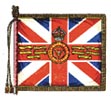 |
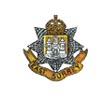 |
|
| King's Colour |
Cap Badge |
|
The 5th and 6th Battalions are Territorial, but the 6th is a
Rifle Battalion and the thus carries no colours. The Colours
of the 5th are exactly the same as those of the 1st, with the
exception of the figure in the center. In pre-war days Territorials
were allowed to embroider on their Regimental Colour only Honours
they had won themselves, these being confined to "South
Africa 1900-2". Now they are alowed to display all the
Honours of their Regular Battalions; in this case the Honour
"Mons", etc, appear on the King's Colour. |
| 1st Battalion
The Royal Sussex Regiment |
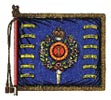 |
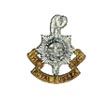 |
|
| Regimental Colour |
Cap Badge |
|
This Colour is of an old pattern, though made shortly after
the South African War, it was presented recently. As it belongs
to a "Royal" Regiment, it is blue, and it bears the
two pre-1914 Honours and the latest post War Honour of "Afghanistan
1919". The 10 Great War Honours are carried out on the
King's Colour. The White Plume was granted in memory of the
regiments's fight with the French Royal Roussillon Regiment
at Quebec in 1759. The Regimental March is the "Royal Sussex".
|
| 2nd Battalion
The South Staffordshire Regiment |
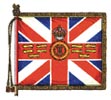 |
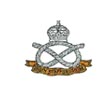 |
|
| King's Colour |
Cap Badge |
|
An unusual feature of the Colours of this battalion is that,
although both were presented at the same time, the Regimental
bears Queen Victoria's crown, while the King's bears the Edwardian
Crown. The former is white with St George's Cross, and bears
the 28 Battle Honours together with the sphinx superscribed
"Egypt" which were gained in pre Great War days, while
the Honours for 1914-1918 follow the unusual rule and are borne
on the King's Colour. The 2nd Battalion were formerly the 80th
Foor, the 1st Battalion being the 18th. |
| 2nd Battalion
Dorsetshire Regiment |
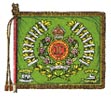 |
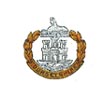 |
|
| Regimental Colour |
Cap Badge |
|
The full dress facings of the Dorsetshire Regiment are grass-green,
and the Regimental Colour of the battalion illustrated is of
that shade. The Sphinx in the Cap Badge and the Battle Honour
"Marabout" were gained by this battalion. The motto
"Primus in Indis" (First in India) which is seen on
the scroll under the wreath in the base of the colour and also
on the Cap Badge, is an alluion to the old 39th Foot having
been the first regiment of the Regular Army to land in India.
In the Great War the Dorsetshire Regiment numbered 13 battalions.
|
| 1st Battalion
The Wiltshire Regiment |
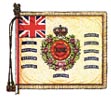 |
 |
|
| Regimental Colour |
Cap Badge |
|
The 1st Battalion of the Wiltshire Regiment (Duke of Edinburgh's)
was formerly the 62nd Foot, the 2nd British Battalion being
the old 99th Foot. The colours of the former are old but in
splendid condition, the Regimental Colour, following the facings
of the regiment numbered 12 battalions, and served in France
and Flanders, Macedonia, Gallipoli, Palestine and Mesopotamia.
The Honours on the King's Colour ranging from "Mons to
"Macedonia", "Gallipoli", "Palestine"
and "Baghdad". |
| 1st Battalion
The Essex Regiment |
 |
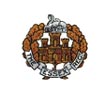 |
|
| Regimental Colour |
Cap Badge |
|
This battalion is one of the few in the Army which still carries
the old pattern big Colour. That illustrated is in very good
condition and has the spear-head top to the Colour-pike and
no golden fringe to the Colour itself. In the Great War the
Essex numbered 31 battalions, and gained 62 Battle Honours,
with 10 borne on the King's Colour. |
| 1st Battalion
Northamptonshire Regiment |
 |
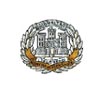 |
|
| Regimental Colour |
Cap Badge |
|
The Regimental Colour is white, with St George's Cross, as the
full dress facings of the regiment are white. The colour of
the 1st battalion which is illustrated is old, and has the Victorian
Crown and Silver Lion on the Colour-pike. The "Castle and
Key" of Gibraltar appear in the Cap Badge and on the Colour,
the latter bearing an addition the Egyptian Honour of the Sphinx.
The Regimental March is known as "the Northamptonshire".
|
| 2nd Battalion
The Queen's Own Royal West Kent Regiment |
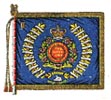 |
 |
|
| King's Colour |
Cap Badge |
|
The Regimental Colour of the regiment is of royal blue, though
in the days before the regiment became a "Royal" one
and donned blue facings, the latter were black, and the colour
was black with a red cross, similar to that now carried by the
20th Battalion of the London Regiment (see 20th
Battalion London Regiment T.A.). The motto is the same as
that of the Royal Artilllery, "Quo fas et gloria ducunt"
(Where faith and glory lead). The latest Battle Honour "Afghanistan
1919" appears on the colour illustrated. The march past
is "A Hundred Pipers". |
| 4th Battalion
The Queen's Own Royal West Kent Regiment |
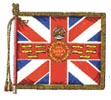 |
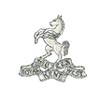 |
|
| King's Colour |
Cap Badge |
|
The two territorial Battalions of this famous regiment (4th
and 5th) carry similar colours to those borne by the Regular
Battalions (see 2nd Battalion The Queen's Own
Royal West Kent Regiment). The "Afghanistan 1919"
Honour on the Regimental Colour is particularly valued by the
4th Battalion. The 10 Honours for the Great War elected to be
borne throughout the regiment are on the King's Colours. |
| 1st Battalion
The King's Own Yorkshire Light Infantry |
 |
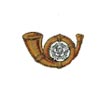 |
|
| King's Colour |
Cap Badge |
|
The present Colours were presented by His Majesty the King at
Buckingham Palace on July 5th 1926. The facings of the regiment
are blue and the Regimental Colour is of Royal blue, and has
the pre-war honours of the regiment thereon, the King's Colour
bearing those for the Great War. In base of the Regimental Colour
is the White Rose of York below the regimental motto, "Cede
Nullis" (Give place to none). This rose also appears on
the Cap Badge, and with the Light Infantry Bugle makes it easy
to recognise. |
|